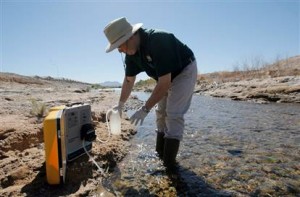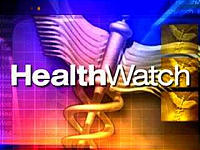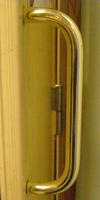Phthalates found in urine of infants after they were powdered or lotioned
CHICAGO – Baby shampoos, lotions and powders may expose infants to chemicals that have been linked with possible reproductive problems, a small study suggests.
Health
Pharmaceuticals lurking in U.S. drinking water
To be sure, the concentrations of these pharmaceuticals are tiny, measured in quantities of parts per billion or trillion, far below the levels of a medical dose. Also, utilities insist their water is safe.
But the presence of so many prescription drugs — and over-the-counter medicines like acetaminophen and ibuprofen — in so much of our drinking water is heightening worries among scientists of long-term consequences to human health.

From California to New Jersey
In the course of a five-month inquiry, the AP discovered that drugs have been detected in the drinking water supplies of 24 major metropolitan areas — from Southern California to Northern New Jersey, from Detroit to Louisville, Ky.
Return of the Plague
Victims of the plague during the 1574 Siege of Leiden by the Spaniards black death black plague bubonic plague

Like no other disease, plague evokes terror. One of the most lethal illnesses in human history, it killed probably a third of Europe’s population in the 14th century. It may also have been one of the first agents of biological warfare: It’s said that in the 1340s, invading Mongols catapulted their plague dead over the city wall into Kaffa in the Crimea.
Yet the plague is not just a disease of the distant past. While cases tapered off in the mid-20th century, the World Health Organization (WHO) now classifies plague as “re-emerging.” No one is predicting another pandemic like the Black Death that devastated Europe. The WHO now records at most only a few thousand cases worldwide per year; and, if detected early, the disease can be treated effectively with antibiotics. But since the early 1990s, plague has returned to places – including India, Zambia, Mozambique, Algeria and parts of China – that had not seen it in many years or even decades.
Men who use mobile phones face increased risk of infertility

Phone the doctor: Men who use mobile phones could face increased risk of infertility
Men who use mobile phones could be risking their fertility, warn researchers.
A new study shows a worrying link between poor sperm and the number of hours a day that a man uses his mobile phone.
Read moreMen who use mobile phones face increased risk of infertility
The Skinny On Miracle Wrinkle Cream
A new wrinkle cream that promises fabulous results. But the question everyone’s asking is “what’s in that cream?”

Barbara Blair says this new gel she’s been using makes her face look a lot younger than the Retin-A and vitamin C creams she’s been using. “It’s really tightened my skin. Firmed it. The little lines are much better. The texture is very appreciably different.” What Blair probably doesn’t know is that a key ingredient in the cream is the foreskin of a circumcised baby. The skin that would otherwise be tossed away. It was first made into a product that helped burn victims heal. Now it’s in this antiwrinkle gel, called TNS Recovery Complex. Betsy Rubenstone is the aesthetician in the plastic surgery department at the University of Pennsylvania and she swears by this stuff. She knows why the foreskin is used. “It’s filled with everything we begin to lose as we age,” Rubenstone says. “And that includes growth factors, amino acids, proteins, collage, elastin and holyuronic acid.” Thomas Jefferson University Hospital dermatologist Paul Bujanauskas says while TNS might have merit, he would not prescribe it for his patients because no scientific research proving its value has been published in medical journals. The cost of one bottle of TNS is about $130. And that will last you about a month and a half. How does it smell? Well that’s another downside. Just ask anybody who uses it. “It’s disgusting. It’s got a sour smell to it that makes you want to gag,” says Blair. “But you get used to it.”
Source: NBC
One in 58 British children is autistic, new figures reveal
A study has found that as many as one in 58 may have some form of the condition – well above the widely-accepted existing estimate of one in 100.
If so, it would mean that around 210,000 children under 16 in the UK have autism or a related disorder.
The leader of the Cambridge University study, autism expert Professor Simon Baron-Cohen, said the higher figure was not linked to use of the controversial MMR jab.
However, two members of his team are understood to privately believe that the triple vaccination may be to blame for the rise.
Their fears follow claims from experts that injecting children with the combined measles, mumps and rubella vaccine – rather than three separate jabs – can cause autism.

Autism is on the rise in Britain
Read moreOne in 58 British children is autistic, new figures reveal
An ancient metal – copper – the new weapon against superbugs

Following research by Professor Bill Keevil at the University of Southampton showing that copper can significantly reduce the presence of MRSA, a Birmingham hospital is to launch an 18-month clinical trial next month (April 2007) to establish whether the installation of copper surfaces will kill MRSA and other hospital-acquired infections.
Laboratory tests by Professor Keevil, Director of the Environmental Healthcare Unit at the University of Southampton, have established that the natural antimicrobial properties of copper and copper alloys dramatically reduce the presence of MRSA compared with stainless steel, the most commonly used surface-metal in health institutions. The MRSA bacteria (staphylococci) on stainless steel remained fully active for days. On brass (an alloy of copper and zinc) they died in less than 5 hours and on pure copper the superbugs were eliminated in 30 minutes.

Professor Keevil explains that copper suffocates the germs. ‘The metal reacts with the bacteria and inhibits their respiration – in effect it stops them breathing. In fact if you look back in the literature the Egyptians were using copper thousands of years ago to treat infections!’
Selly Oak has been chosen for the Copper Clinical Trial because it is a multi-specialist centre with an advanced microbiology centre. One general medical ward is already having copper installed in preparation for the trial. Because 80 per cent of MRSA transmission is through surface contacts, stainless steel door handles and push-plates are being replaced by copper, along with bathroom taps, toilet flush-handles and grab rails. Even the pens used by the staff will be a high-copper brass. A similar ward next door will retain its traditional metal fittings and will act as a control in the experiment. If the laboratory results are successfully replicated, it is likely that thousands of hospitals across Europe will introduce copper alloy fittings.
Deputy Medical Director of the University Hospital Birmingham NHS Trust, Professor Tom Elliott, says: ‘Potentially it is very, very exciting if we find that copper actually works in a clinical environment, following the laboratory tests in Southampton and here in Birmingham.’
The tests show that it is not just MRSA that can be killed by copper. The newer threat, the extremely resistant Clostridium difficile can also be killed, as demonstrated by preliminary tests. Scientists are already considering wider medical applications for copper, including a possible defence against bird flu. Experiments by the Southampton team have shown that the metal can kill the human flu virus. Professor Keevil says, ‘Avian flu is almost identical to normal human flu so, although we haven’t done the work yet, we would predict the same results.’
The Copper Development Association has been working with the supply chain to support the development of copper and copper alloy healthcare products for the trial through the provision of information on the efficacy of different copper alloys and their suitability for different applications. www.cda.org.uk/antimicrobial.
13 March 2007
Source: University of Southampton
Tamiflu drug made with cocktail of chemical ingredients, linked with bizarre behavior

(NaturalNews) According to a list compiled by Dr. Patricia Doyle at rense.com, a host of strange ingredients are used to make up Hoffman-La Roche’s anti-flu drug Tamiflu, which has recently been connected with bizarre behavior, mostly in children.
Patients using Tamiflu — which many nations are stocking up on as a way to combat a possible pandemic of the deadly H5N1 bird flu — reported delirium, hallucinations, delusions, convulsions, disturbed consciousness and abnormal behavior. The FDA reports that side effects reported with Tamiflu include nausea, vomiting, diarrhea, bronchitis, stomach pain, dizziness and headache.
Three people on the drug have committed suicide by leaping to their deaths, and one Japanese child reportedly ran out of his house and responded to his name in growls after treatment.
According to Doyle and internet drug index RxList.com, the 75-milligram Tamiflu capsules contain:
Oseltamivir phosphate – The active ingredient in Tamiflu
Black iron oxide (E172)
Croscarmellose Sodium
FD&C Blue 2 (indigo carmine, E132) – A synthetic dye
Gelatin – A protein product traditionally made with animal byproducts
Povidone
Pregelatinised maize starch Red iron oxide (E172) Shellac – A “natural plastic” secreted from the female lac insect. Sodium Stearyl Fumarate Talc – Preliminary links between talc and pulmonary issues, lung cancer, skin cancer and ovarian cancer have been established in studies
Titanium dioxide (E171) Yellow iron oxide (E172)
The 12-milligram oral suspension of Tamiflu contains:
Oseltamivir
Saccharin sodium (E954) – A chemical sweetener linked to cancer in some studies
Sodium benzoate (E211) – When combined with absorbic acid (vitamin C), sodium benzoate can form benzene, a known carcinogen
Sodium dihydrogen citrate (E331 (a))
Sorbitol (E420) – A sugar substitute that can cause gastrointestinal problems
Titanium dioxide (E171)
Tutti Frutti flavor
Maltodextrins (maize)
Propylene glycol – Although generally recognized as safe (GRAS) by the FDA, propylene glycol is used as a food-grade antifreeze and is the primary ingredient of the paint inside a paintball
Arabic gum (E414)
Natural identical flavoring substances (mainly banana, pineapple and peach)
Xantham gum (E415)
Doyle warns that the reactions possibly linked to the drug warrant caution and she suggests that anyone who has reacted to Tamiflu in the past discontinue use and consult a medical professional. She adds that the medicines chlorpropamide, methotrexate and phenylbutazone may adversely react with Tamiflu.
“This list of ingredients is downright amazing,” said Mike Adams, author of “How to Beat the Bird Flu.” “It contains an antifreeze used to winterize RVs, a chemical sweetener known to promote cancer, and a chemical preservative also known to promote cancer. Is it any wonder this drug, with all its chemical interactions, causes some people to go crazy and leap from tall buildings?
“This is yet one more reason why the public needs to be informed about safe, natural anti-viral herbs and bir remedies,” he said. “The active ingredient in Tamiflu is derived from a Chinese medicine herb, for example, yet no public official is telling people the name of that herb. They want Americans to buy the high-profit medicines, not stock up on natural herbs.”
Friday, November 17, 2006
by: Ben Kage
Source: Natural News
Beyond Treason
Beyond Treason investigates causes of Gulf War Illness and continuing deaths of gulf war veterans. Beyond Treason outlines: – exposure to depleted uranium munitions used on the battlefield. – chemical and biological exposures. – experimental vaccines given.
Statistics show that 250,000 troops are now permanently disabled, 15,000 troops are dead and over 425,000 are ill and slowly dying.
Beyond Treason 100 minute documentary presents comprehensive and compelling documentation from United States Government archives of a massive cover-up lasting over two generations.
Over 70,000 deaths, and over 1 million disabilities among American soldiers attributed to Iraq Wars says U.S. government data
The video has been removed before. Let me know if this happens again.
Ginger causes ovarian cancer cells to die, U-M researchers find
Cell studies show promise for ginger as potential ovarian cancer treatmentNotice to patients: This study represents very preliminary research findings made in the laboratory. Further testing is needed before researchers know how or if ginger should play a role in the treatment of ovarian cancer. U-M researchers do not recommend taking ginger as treatment for cancer. Please talk to your oncologist before taking any dietary or herbal supplements. For more information about ovarian cancer treatment, call Cancer AnswerLine at 800-865-1125.
ANN ARBOR, MI – Ginger is known to ease nausea and control inflammation. But researchers at the University of Michigan Comprehensive Cancer Center are investigating a new use for this age-old remedy: treating ovarian cancer.

J. Rebecca Liu, M.D.
In laboratory studies, researchers found ginger caused ovarian cancer cells to die. Further, the way in which the cells died suggests ginger may avoid the problem common in ovarian cancer of cells becoming resistant to standard treatments.
Read moreGinger causes ovarian cancer cells to die, U-M researchers find